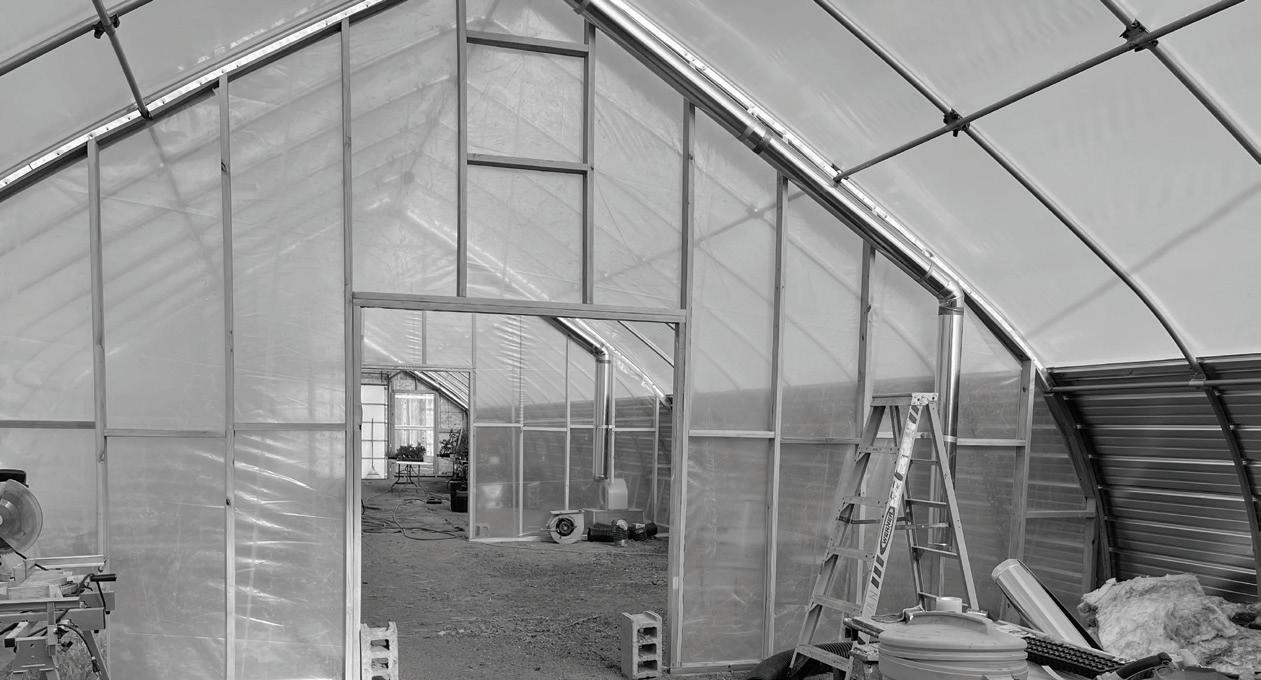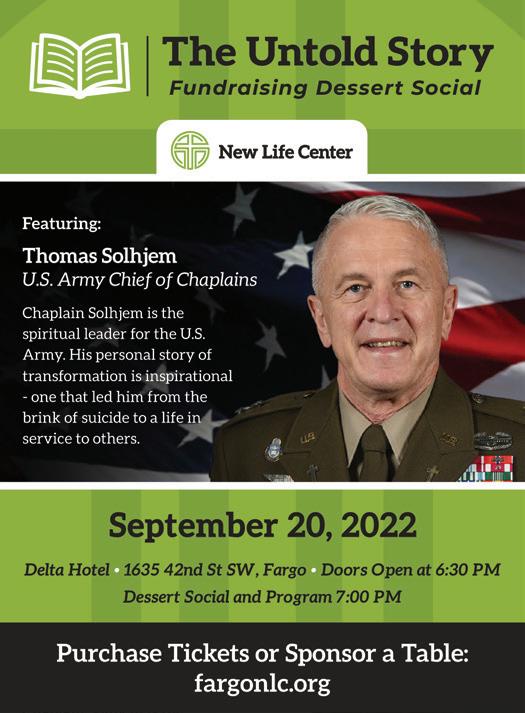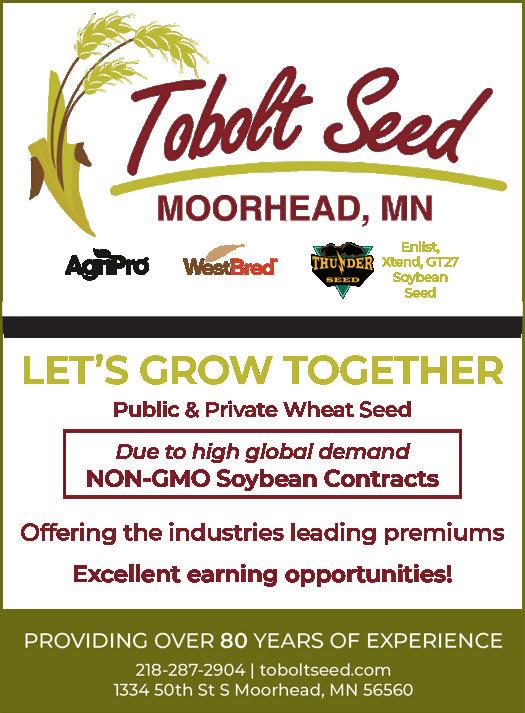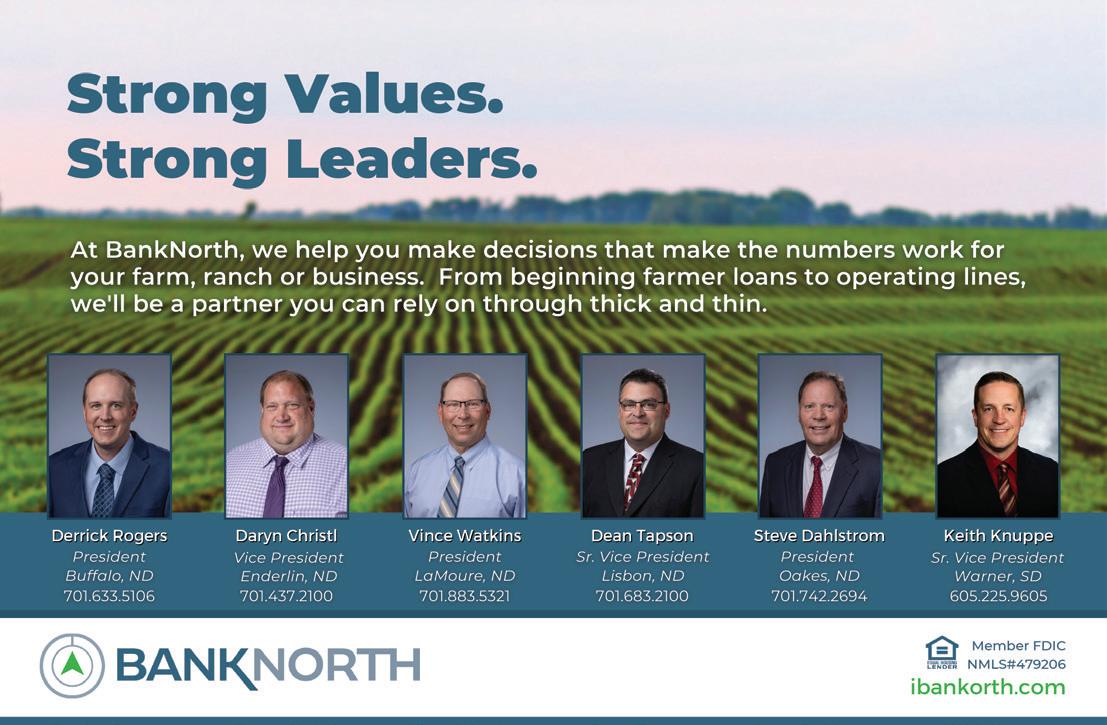
9 minute read
THE FARMSTEAD 2.0
Photo Courtesy of Quinn Renfandt
North Dakota farmer Quinn Renfandt is bringing new life into the way of small-scale, sustainable farming
How Renfandt is Setting an Example For Local Producers

ABOUT QUINN RENFANDT ABOUT QUINN RENFANDT
Quinn Renfandt is a beginning farmer originally from Minot, N.D. He is a Special Projects Technician with the Entrepreneurial Center for Horticulture located on the campus of Dakota College at Bottineau. Aside from his own history and interest in farming, Quinn has an extensive resume when it comes to sustainable agriculture. He is a Foundation for Agricultural and Rural Resources Management and Sustainability (FARRMS) Sustainable Agriculture Internship graduate and FARRMS Farmers Market Promotion Program Internship graduate, as well as a Farms Beginnings Course graduate. In addition to his background, Quinn is a founding member and the newly elected President of the Red River Harvest Cooperative. He has also been appointed to the North Dakota Farmers Market and Growers Association Board of Directors as the official representative for the Southeastern District of North Dakota. His current project has been in works for three years this summer, and he was willing to share his endeavors with the readers of Future Farmer.
When you think North Dakota winters, you don't think about abundant produce production. However, Quinn Renfandt, a man who is very involved in the local food production scene, is trying to show that growing during our region's harshest season is not an impossible task while also pushing forward efforts for efficient, sustainable and profitable local food production.
Renfandt, who is the President of the Red River Harvest Cooperative Board of Directors, recently managed a farmer's market commercial program grant with the North Dakota Farmer's Market Grower Association that canvassed North Dakota as a whole as well as the farmer's market scene in order to assess where we're at in the region in terms of production and local value. The personally funded year-round greenhouse growing project that Renfandt is building out on his family farm, he sees as his personal contribution to this scene.
Utilizing a greenhouse to grow produce year-round in harsh winters is nothing new. However, the sustainable way in which Renfandt is attempting to do it is not commonly practiced in the region.
THE SPECIFICS
The project, which is in its third year and is entering its first operational winter growing season, is the product of observations Renfandt has made about how people around the world are growing food on small scales. "A lot of it has been [from] YouTubing things and learning that way. It's really nothing new," Renfandt said. "It's really to balance an ecosystem in a sustainable manner. I managed to get
THE MISSING PIECES
Ideally, when we step back and look at our region’s food system, we should see a dynamic network of stakeholders producing, processing, consuming and distributing as much of the population’s food as possible. This food is also purchased at multiple scales and levels within the same region, resulting in significant economic and social returns to all stakeholders, further maximizing resilience and minimizing importation needs. When we look at the current status of our region’s actual food system, we’ll find many missing pieces, including the network itself. This leaves our citizens and communities without the major benefits provided by a regional food system. So, what are the missing pieces? And after identifying those pieces, where do we begin our efforts in establishing a more sustainable regional food system? Before answering those questions, I’ll outline a little more context to concentrate our focus on small-scale food production.
SMALL-SCALE FOOD PRODUCTION
A regional food system is extremely complex and involves many moving parts. For example, let’s look at local producers and growers selling to a farmers’ market. A local grower looking to start producing fruits, vegetables and/or value-added products for the local farmer's markets will need a few basic things.
• A place to produce their products, which could be land or some controlled environment facility. • A place to sell it, in this case, the farmer’s market. • Transportation to bring the products to the market and customers.
Beyond this, there are licenses and paperwork too, but I am primarily focusing on the continuous activities needed to successfully generate income as a small-scale farmer.

• After transporting the products to the market, the grower entrepreneurs need to devote time and energy to marketing their products. • Equally, if not arguably more important, they have to integrate themselves as part of the brand to prospective customers. • If a producer wishes to move beyond the farmers market arena, let’s say local restaurants or maybe an institutional buyer, i.e., hospitals, schools, etc., they also must keep records of everything that is happening in their operations, as required by the health department.
All these things are needed to even begin growing as an individual producer. Most producers in the region are on their own for most of these tasks. They are limited to the labor available to them and their operation. When we ask the question of what is missing from smaller-scale growing and farming operations in our region, understanding the amount of physical work the production process requires is crucial to begin to understand what they may need.
The greatest barrier for producers right now is the cost to get their products to customers and the climatic factors influencing the length of each growing season, which further limits their production capacity. This in turn makes it unreliable for local customers and other food businesses—including grocery stores and restaurants—to source local goods.
WHAT IS THE FARMSTEAD 2.0?
This is where Farmstead 2.0 comes to life. In short, the idea of creating the next-generation farmstead comes from my personal experience. My original intention was to focus on improving the food being served in schools near my farm. Selling produce at this scale is no easy endeavor. I realized I knew very little about farming practices and techniques when I set out to grow produce. No one had farmed in my family in over two generations, so there wasn’t anyone I could learn the old, traditional ways from directly. As I looked to the newer technological approaches, I soon concluded that these were beyond my means to use for learning. Instead of walking away, I decided to see the hidden advantages in an unfortunate circumstance and took it upon myself to learn by doing. My desire to do this can be found in nature.
There are changes happening across the globe right now, causing shifts in our weather patterns here in this region. Most of the food consumed here is imported. Meaning our most fundamental and mutually shared needs for nutrients is entirely beyond our control and reliant on a complex globalized supply chain that isn’t very adaptable to change, especially nothing immediate or abrupt. North Dakota sits in the geographical center of the North American continent. Another way of thinking about this is to imagine a line of people that’s about ten people long, and right now you’re standing at one of the ends. The person at the other end is handed a loaf of bread and is instructed to take what they need then pass it to the next person. No matter what, you will be the last person to receive what’s left of the loaf and you are entirely at the mercy of everyone else before you. This is where North Dakota stands in the global supply chain line. I don’t know about you, but considering recent events that proved this scenario to be true, I believe we need to rethink how we manage our food supply in this region. Farmsteads of the future will need to address and overcome this fault in our system.
my greenhouse material from a greenhouse business that had gotten shut down. So that part is recycled. All of the tubing and everything was purchased from a local store. All of the fans are recycled fans from old furnaces— getting those was just a matter of seeing when people got a new furnace and dumped their old one at the dumpster."
In addition to the sustainable sourcing of materials, Renfandt has a goal to ultimately make his greenhouse energy positive, or at the very least, energy neutral.
"That will mean using geothermal heat instead of fossil fuels, using solar panels and using and storing heat from the compost pile for use through the winter as well," Renfandt said. "I'll also be using basic sensors to monitor everything like the humidity for example. So I can know what will work in my greenhouse and what won't."
For now, Renfandt will start with heirloom tomatoes grown either in soil or with a hydroponic setup with a goal of eventually having a fully autonomous, year-round, sustainable greenhouse with an aquaponic setup for efficient protein production as well.
"That's where I want to get with that," Renfandt said. "However, the learning curve there is quite long. That's why I'm starting with the heirloom tomatoes, in order to build everything out."
THE HURDLES

During his work with the North Dakota Farmer's Market Growers Association, Renfandt identified connecting local producers with customers as well as the biggest hurdle facing small-time producers.
"It's very difficult trying to create your own basic distribution network for your food," Renfandt said. "If you aren't big enough, you're not going to have enough produce to tap into the major carriers. So then, what do you do? Most of the grocery stores already have their own transportation networks. So getting your food from point A to point B and building those relationships with purchasers is a really big hurdle. Addressing that is really about connecting with people and trying to get them to understand why they want to buy local or what that means to them, whether it be about the environmental benefits or economic benefits of investing in the local area."

When it comes to the actual nuts and bolts of his personal greenhouse project, the biggest hurdles Renfandt is facing along his path to his ultimate aquaponic goal (in addition to the vast learning curve), is the implementation of energy production for the greenhouse.
"The expense for solar is something I haven't figured out yet," Renfandt said. "I'm not sure how I want to tackle that. Until I do, I will need a minimal amount of energy from the grid for the lighting, fans and internet for the sensors."
THE BENEFITS
One of the biggest lessons we've learned since the onset of the COVID-19 pandemic is the importance and vulnerability of the supply chain. For many products, supply chain disruptance is an annoyance. For a region as desolate as ours is in the winter, a major food supply chain issue could have devastating effects, hence the focus to figure out year-round sustainable local food production in our region, just as Renfandt is attempting to do.
"Ultimately, we have an environment that's changing on a global scale. Supply chain issues are happening on a global scale. My argument for localizing food isn't necessarily an economic argument. My argument is that this is better than having no other option. In the winter, we are very vulnerable here with us having to transport foods such great distances."






